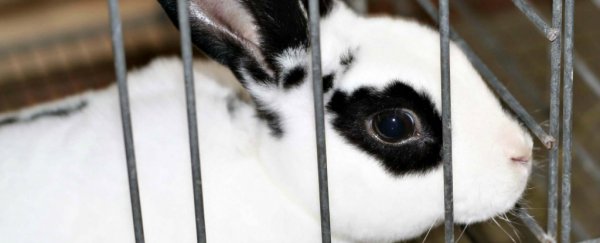Many of us try to avoid cosmetics that are tested on animals, but it's widely assumed that without trialling chemicals on real skin, scientists won't be able to figure out how the human body will react to a new product.
But that's not going to be the case for much longer, according to mathematicians who say they've developed a model that can effectively predict how human skin will handle almost 30,000 chemical compounds. So maybe it's time we chill out with all the animal testing already?
"A lot of people have models, but we have predictive models," said lead researcher Gerald Kasting from the University of Cincinnati.
To make their model, Kasting and his team used data on the results of testing chemical compounds on human skin in the lab to measure, in detail, whether they were absorbed, how they were transported within in the dermal layers, and whether or not they had the potential to produce an allergic reaction.
From those results, they were able to create a mathematical model that could predict how skin would react to tens of thousands of other compounds - without any humans or animals being harmed.
"Instead of doing testing on 30,000 compounds, we are able to test a subset of say 200 and make predictions about the other 29,800 based on the subset," said Kasting.
The research was presented at the annual meeting of the International Society of Porous Media last week, and it has yet to be peer-reviewed, so for now, we have to take Kasting's word for it. But if verified, this technology could help reduce or even replace the amount of animals needed to test cosmetics and consumer products.
Using maths to replace animal testing isn't new - researchers have been trying to do this for years. But it's always been held up by one big problem: mathematical models are only good as the data we input.
As mathematical and computational blogger Mark C. Chu-Carroll wrote (pretty heatedly) over on Science Blogs back in 2010:
"If we really understand what we're simulating, we can do simulations that are astonishingly accurate … But we can't simulate something if we don't know how it works. And that's the problem with biological simulations … When it comes to biology, we just don't know enough to be able to accurately or even meaningfully simulate many simple processes."
And that's a very valid point. But over the past six years, we've learnt a lot about skin - particularly how chemical compounds move through it. And it's this detail that Kasting focussed on for his research.
He admits that mathematical models aren't yet sophisticated enough to establish proper safety profiles for chemicals, but they could be a great starting point for determining which compounds are going to set off a skin reaction and which aren't - and that could save a whole lot of animals from being used in testing that goes nowhere.
One red flag worth mentioning is the fact that the meeting this research was presented at was co-sponsored by Procter & Gamble, who have a financial interest in these kinds of findings, as well as several academic institutions. But that said, this research specifically wasn't funded by P&G, and it doesn't necessarily seem like a bad thing if a global pharmaceutical giant is spending money on looking for alternatives to animal testing.
In fact, it's in their best interest to do so, seeing as models like this could save them time, as well as hundreds of thousands of dollars (if not millions) on failed experiments.
"In order to produce globally, companies need to meet and adhere to the most stringent guidelines," said Kasting. "Potentially troublesome ingredients such as fragrances and preservatives are widely used in the cosmetic and personal care industry, so manufacturers are very interested in ways to improve testing."
We should add that sometimes experiments on animals really are unavoidable - at least for now, anyway. As sad as that is, research involving animals has helped to advance medicine and science to the next level, for which we're forever grateful.
But if these models can offer a way to effectively replace most, or even just a few, of the animals used in this kind of testing, then we're all in. Who knows, maybe one day they could even predict how new drugs will work, or whether or not a vaccine will be effective, without animals getting involved.
The only way to find out is to keep on researching. It's worth it.
Update 27 May 2016: This story has been updated as an earlier version incorrectly implied that Kasting and his team had tested their initial chemical compounds on animals. They actually based their models on testing on human skin in the lab.
